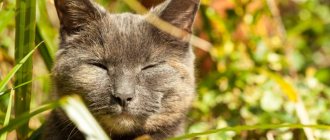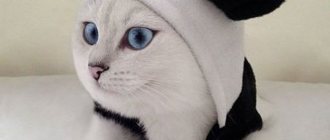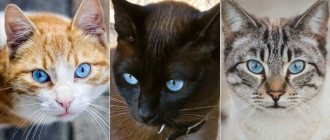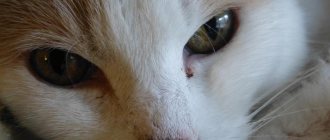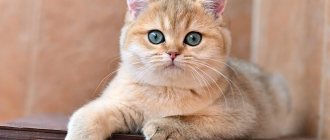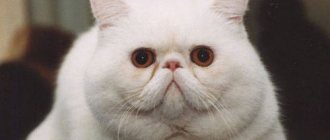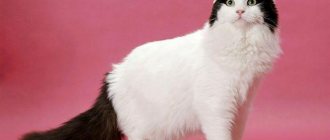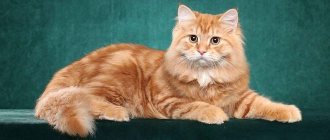Features of white cats with blue eyes
White cats are active and inquisitive, they like to climb onto cabinets and examine household members or hide under the bed.
White cats are gentle and affectionate. They do not tolerate rudeness and cruelty. Animals love to be the center of attention and are able to detect the slightest changes in the owner’s intonation. Cats won't force themselves when they realize it's inappropriate.
Snow-white beauties prefer to sleep in the arms or next to the owner. They are quite smart and well trained. Owners of white cats note that their pets quickly become accustomed to the litter box and maintain the cleanliness of their luxurious coat on their own.
Kobe the cat
Genetics of this color
Three genes are responsible for the purity of white color:
- With albinism;
- W white color;
- S piebald.
If a female with the dominant white W gene is crossed with a cat of a different color, the kittens will repeat the color of the mother. The combination of two W genes produces variegated offspring. The iris of the eyes of such animals is bright blue or blue, topaz or green.
The S piebald gene is present in animals with white spots on the background of the main one. Visually, a cat is perceived as pure white if the spots merge. Eye color can be blue, yellow, green.
Advantages and disadvantages
Advantages of snow cats:
- peacefulness;
- friendliness;
- self-esteem;
- affectionate disposition;
- agreeableness;
- sensitivity.
Disadvantages: hearing loss and the need for careful grooming.
Scottish fold
Scottish Fold is a breed of white fluffy cats that is very popular. The standard does not allow the presence of smoky spots. The pet's coat should be pure white. A special feature of the breed is the smoky spots that appear at an early age in kittens. But over time they completely disappear. Scottish cats have a pink tint to their pads and nose, and their eyes can be blue or gold.
The animals attract attention with their incredibly soft plush fur. Cats' ears have a characteristic curve. The breed appeared in the sixties of the last century as a result of a random mutation. Since then they began to actively breed her. It is worth noting that the Scottish Field is a classic sofa breed. Its representatives adore comfort and warmth. But at the same time, cats show independence. A characteristic feature of the animals is their squeaky voice. Cute pets get along well not only with all family members, but also with other animals. Cats love to play, but very often behave independently.
Cat breeds
White coat color is characteristic of many cat breeds. However, there are varieties for which only a white coat is acceptable. These are forinwhite and kao-money.
Khao-mani
Khao Mani is a cat breed native to Thailand. Translated from Thai, the name of the breed means “white gem”. In English, cats are called "diamond eyes". The distinctive features of the animals are snow-white fur and multi-colored irises.
Kittens are born with a dark spot on their head, but it disappears with age. Sometimes there are cats with spotted fur. The color of the iris can be amber, green, blue. About 50% of animals with heterochromia have hearing loss in one or both ears.
By nature, Kao-Mani are active and cheerful, they love to “talk” with their owner.
Reference. Khao Mani is an ancient breed. She is mentioned in the manuscript “Book of Poems about Cats.” For several centuries, cats were kept only at the royal court.
British
White Britons have the same breed characteristics as their blue counterparts. The fur is just as plush and soft. The iris is blue or heterochromic (one eye is blue, the other is orange). The British are famous for their calm and somewhat phlegmatic character.
Scottish
The Scottish Fold cat can be not only gray, spotted, tabby, lilac or black, but also white. There is also a straight-eared variety with the same plush fur. The solid white color is accompanied by a blue iris or heterochromia.
Maine Coon
The Maine Coon is a long-haired, large-sized cat with a stern look and charming tufts on its ears. The breed standard allows for a variety of colors, including snow-white, although it is much less common. The iris of the eyes is amber, green, blue or multi-colored.
Javanese
The Javanese breed is descended from the Siamese and Abyssinian breeds. White color always goes with blue eyes. The coat is long, the hairs are thin and prone to tangling.
Norwegian forest
The Norwegian Forest cat is a long-haired cat of large size. Any color is acceptable, but white is rare. That is why he is valuable. Slanting almond-shaped eyes are predominantly green and amber in color.
Manx
Manxes are adorable tailless cats and often have white fur with small black and tan spots. The iris of the eyes is green, blue, amber.
Neva Masquerade
The Neva fluffy beauty has a mask on its face that resembles a masquerade mask. The color usually combines snow on the body, a dark mask on the face, smoky toes on the legs and a dark blotch on the tail. The iris is usually blue, heterochromia occurs.
Exotic
Exot is the same Persian, but with short hair. The breed is often called a Persian for the lazy, because caring for a fur coat is not as burdensome for the owner as compared to daily combing the shaggy hair of a Persian cat. The snow-white color is rare and highly valued.
Cornish Rex
Cornish Rexes are funny babies that resemble a shorn lamb with curled wool. Snow-white, blue-eyed cats are rare. The color is clean, without inclusions. Paw pads are pale pink. Eyes blue or amber.
The final appearance of the coat is formed closer to the year. The body of the animal is covered with wavy fur. It seems that the styling was done by a professional groomer, and not by nature itself.
Oriental
There are a great many color options for the Oriental cat. Absolute white without yellowness is especially valued. The iris is green, topaz or blue. You can drown in such eyes! Heterochromia is also acceptable.
Snow Bengal
Absolutely white Bengals do not exist in nature. Even the snow color is still accompanied by a rosette. Experts distinguish three types of snow color:
- Lynx (photo below) is the whitest, the spots are almost invisible. The iris is bright blue. There is no heterochromia, nor is there hereditary deafness.
- Mink - the main background is gray and white, tabby pattern. The eyes are gray-blue with a greenish tint.
- Sepia - warm honey background and dark tabby. Eyes with yellow or aquamarine.
Himalayan cat
The Himalayan cat is a color-point Persian. The main coat color is white, and the face is decorated with a cream-colored mask.
Anatolian cat
The Anatolian cat is a native breed, presumably a short-haired variety of the Turkish Van. There are numerous color options, including pure white or white with red spots. Heterochromia is acceptable.
Persian cat
Snow-white Persians have a soft undercoat. Eye color: honey, amber, blue. There are individuals with heterochromia.
Turkish van
The Turkish Van is a long-haired cat with a snow-white coat and single colored patches on the head, paws and tail. The iris is blue, amber, green.
Russian white
The Russian White is a rare breed created by crossing the Russian Blue and the Siberian Snow cat. The coat is short and white. The iris is green. The breed is registered in Australia, New Zealand, and South Africa. In the USA and EU, the Russian Bela is still listed as an experimental breed.
Turkish Angora
The Turkish Angora is a beautiful cat with semi-long, dry and thin, crumbly hair of different shades. However, the white color is considered original. The iris is blue or heterochromic.
Balinese
The Balinese cat is a long-haired variety of the Siamese. Long hair appeared as a result of a natural mutation. The color is color-point, the main background is light, often white, the points are dark. There are also pure white Balinese dogs.
Foreign white
Foreign White is a pure white cat breed. This color was achieved through scrupulous genetic selection and inbreeding of ordinary Siamese.
The peculiarity of the breed is that, having blue eyes, cats do not suffer from deafness. Geneticists suggest that this is due to the long isolation of Siamese cats from other species and the purity of the line. There is confirmed evidence that hearing loss was transmitted through the line of Angora cats.
Reference. Translated from English, foreign white means “white foreigner”. The breed was registered in 1966 in Britain.
Turkish Angora
There are different breeds of white fluffy cats, among them the most popular are Persian cats. The animals have a harmonious physique and beautiful color. The almond-shaped eyes of cats are slightly slanted. This breed can have green, blue, orange, yellow and amber eyes. White cats have a long tail that resembles a peacock feather. The breed first appeared in Turkey.
Now it is highly valued in the country. Animals with eyes of different colors are considered especially popular, despite the fact that they often cannot hear in one ear. By the way, Turkish Angora cats are considered one of the most valuable animals in the world. A description of the breed would not be complete without recalling their affectionate and gentle character. They are distinguished by great friendliness and calmness, which is important. The fact is that not all purebred animals have an easy-going disposition. The breed of white fluffy cats is far from cheap. An animal can cost 360–900 dollars (about 24–60 thousand rubles).
Breeds of long-haired blue-eyed cats
List of longhaired cats:
- Maine Coon;
- Persian;
- British and Scottish Longhair;
- Turkish van;
- angora;
- Javanese;
- balinese;
- Norwegian forest;
- Neva Masquerade.
Shorthair
List of cats with short hair:
- British;
- Scottish;
- Manx;
- exotic;
- Cornish Rex;
- oriental;
- Bengal;
- Himalayan;
- Anatolian;
- Russian white;
- foreign white
Bald
The white Sphynx has no fur. His skin is light pink, almost white, and his eyes are blue. Animals need careful care. They feel comfortable only next to their beloved owner.
Cornish Rex
Among white cats you can find very unusual pets that have curly hair. These include representatives of the Cornish Rex breed. By the way, such cats are recommended for people prone to allergies, since their fur is hypoallergenic. Animals do not have guard hairs, so they do not shed. Pets look incredibly elegant. They are decorated with a pink nose and the same paw pads, as well as beautiful golden or blue eyes. Cornish Rexes are incredibly smart. They are created for close communication with people, and therefore do not tolerate loneliness well. Animals have a cheerful and affectionate character; they love children very much. The breed was developed completely by accident, and the unusual color was the result of a gene mutation.
The peculiarity of pets' fur is such that it does not require regular brushing. In addition, cats do not shed, which makes it easier for owners to care for them.
Nuances of care
A snow-white fur coat needs careful care:
- it is necessary to monitor the cleanliness of the house;
- brush and bathe your cat regularly, especially after walking outside;
- do not let the animal go for a walk in rainy weather;
- wash your eyes and clean your ear canals;
- change the filler in a timely manner;
- monitor nutrition - provide super-premium food;
- carry out deworming once every 3 months;
- treat for fleas and ticks twice a year;
Characteristic diseases
Snow cats are generally healthy, but heterochromia is common among individuals with heterochromia and blue eyes.
For example, Scottish fold cats suffer from pathologies of the cardiovascular system, have problems with the kidneys and teeth.
Persians have breathing problems due to the special structure of the skull and the curvature of the nasal septum. Animals suffer severely from renal failure, viral rhinotracheitis and hypertrophic cardiomyopathy.
Exotics are prone to conjunctivitis.
Orientals have digestive problems, suffer from bronchial asthma, heart pathologies, and strabismus.
Balinese dogs are diagnosed with congenital heart defects.
Why is deafness common among white cats?
In 1997, scientists conducted a study in which they were able to find out some facts about deafness in cats:
- Deafness can be complete or partial.
- Hearing loss is diagnosed in 20% of cats with a white coat and an iris of any color other than blue.
- 40% of all cats with heterochromia are deaf. Hearing loss is detected in the ear on the side of the blue eye.
In addition, scientists have explained the cause of hearing loss in cats. Responsibility was assigned to the insidious mutant gene Dominant White (W-). At the stage of embryo formation, melanoblasts are formed in the area of the neural tube, which produce pigment and transport it to the retina. With normal embryo development, the pigment is delivered on time. These kittens are born with yellow or green eyes.
But as soon as the mutant gene gets involved, the speed of transport of melanoblasts decreases. The pigments do not have time to reach the skin and fill the follicles. The same thing happens with the retina - the pigment does not arrive. Sometimes a minimal number of melanoblasts reach their targets, so only some areas remain white. If the pigment fills the iris minimally, then kittens are born with heterochromia. One eye is blue, the other is yellow.
Scientists continue to study the effect of the gene on the body of cats, because snow-white individuals have a decrease in reproductive function and vitality.
Reference. Genetics have also identified factors that increase the likelihood of deafness - long hair and blue irises.
Albinism in cats
Albinos are also found among cats, just like other representatives of the animal world. From a scientific point of view, an albino cat is absolutely colorless, since the “ca” gene is present in its genetic makeup. It is he who is responsible for the lack of pigment in the color.
Pure albinos with red irises are rare. The most common are albinos with faded blue eyes. The “c” gene is responsible for the coloring of such special ones.
There are complete and partial albinism. In the case of complete disease, the body lacks the enzyme tyrosinase. This variety is observed in 1 case out of 10 thousand.
With partial albinism, the enzyme is present in small quantities, and the melanin produced is not able to color the entire body. In such individuals, most of the body remains white, and individual parts are painted in different colors.
Interesting. Often females, not males, are born full albinos.
Maine Coon
White Maine Coons look absolutely stunning. The standards allow only pure white color, without any inclusions. In combination with such fur, golden or green eyes with blue irises look very impressive. The paw pads and noses of animals are pink. Characteristic features of the breed are cute tufts on the ears and very thick hair.
America is the birthplace of this beautiful breed. Its representatives are considered one of the largest. Animals are adapted to cold winters. The appearance of Maine Coons is distinguished by their beauty, which could not but leave an imprint on their character. Animals know their worth and never impose themselves. But at the same time, they do not lose sight of the person. Cats must be sure that their owner is somewhere nearby. Maine Coons try to lead over other animals. If there are already pets in the house, the cat will try to become a leader.
It is worth noting that Maine Coons have one more feature - their voice. The intonations of their meows are very diverse and expressive.
Signs and superstitions
Snow-white cats, perhaps, do not have as many conjectures and prejudices as black cats have. All signs and superstitions about white cats are positive:
- A stray cat with white fur brings good news and change.
- Such a cat is able to protect the house from the evil eye and all evil spirits.
- In some countries, a white cat is considered a mascot. People keep such animals in their homes because they believe that they bring good luck and prosperity.
- Girls who want you to get married as soon as possible should place 7 snow-white kittens in good hands.
- Women are advised to keep a cat with different colored eyes at home if she wants to remain attractive to men.
- If a white cat gets in the way of the newlyweds, they will have a happy and long life together.
- If a white cat crosses the road, you should make a wish.
- Snow-white murki collect negative energy, relieve stress, and guarantee success in any endeavor.
Such animals balance the psyche, normalize the functioning of internal organs, enhance brain activity, and eliminate depression. At least that's what scientists say.
Russian white
This breed was obtained by crossing a Russian Blue and a white Siberian cat. An elegant cat with short, iridescent snow-white fur and emerald eyes quickly won the hearts of breeders from many countries. She is gentle, affectionate with people and extremely attached to her owner. Today this breed is actively bred on the Australian mainland, in New Africa, and this breed has received experimental status in European countries and the USA. Unfortunately, there are no representatives of this breed in Russia yet.
Color and deafness
Many white cats are deaf due to inner ear degeneration. Geneticists studying these animals have determined that their deafness depends on eye color:
- 17-22% with eyes of any color except blue;
- about 40% are heterochromic (i.e. with different colors);
- 65-85% with blue eyes.
In cats with different eyes, hearing loss is usually observed on the side of the blue eye.
Kao-mani with blue eyes
The cause of deafness is in the dominant W gene. After much research, scientists have determined that it is pleiotropic - it is responsible for a number of traits in the genotype - not only for coat color, but also for deafness and blue-eyedness. By the way, you can also read about blue-eyed cats and breeds on our portal.
The dominant W allele disrupts the migration of melanoblasts—pigment producers and transporters—and also affects the activity of other cells in the area of the neural tube of the embryo
Deaf cats are excluded from the breeding program. And as a pet, they can live as absolutely full-fledged individuals; the lack of hearing is compensated by other senses. True, such animals will not survive on the street.
Eye colors
Cat with green eyes
The most common cat eye color is green. This color goes well with any color, including gray striped. Very bright, emerald or grassy, rare. Much more often the eyes have an olive or gooseberry tint.
Almost as often, cats have yellow eye shades - light lemon and yellow-green.
Orange iris colors look very impressive and are usually found in ginger cats. Shades range from copper to amber-walnut.
In a white cat with green or yellow eyes, the coat color is controlled by the piebald gene.
The rarest of colors is blue, from light to rich. Typically, white cats have blue eyes, unfortunately, which are associated with various diseases that are associated with the white gene.
An extremely rare case is heterochrony - different colors of the iris. That is, when a cat has one eye, for example, blue, and the other orange. For cat lovers, this combination is considered the most desirable.
Recommendations for care and education
- You need to take care of upbringing thoroughly and immediately as soon as the kitten appears in the house. First, he must understand that he occupies a subordinate position and the boss here is the master.
- Under no circumstances should you raise your voice at your pet or, especially, hit it.
- In the first few days, you should limit the space in which the kitten lives to a separate room where there will be no secluded corners. Of course, you need to provide the kitten with bowls for food and drink, a toilet and a house.
- You cannot take a kitten out of the house by force - this is his personal territory.
- You should not play with a kitten with your bare hands.
- Changing the daily routine is contraindicated.
- When changing food or filler, you need to accustom it to the new type gradually, gradually replacing the old one with the new one.
- If you plan to walk on a leash, then you need to accustom the kitten to it little by little, adding more time to wearing it. First, put on the leash for five minutes, increasing the time each time.
You need to raise a kitten immediately after its birth.
You need to monitor the cat’s health through its behavior, which changes very noticeably when sick.
The coat of any white cat breed requires careful care, because any dirty spot or matted knot will be visible from afar. You need to get used to the fact that you will have to brush your cat every day. And it’s better to accustom her to this procedure from early childhood, so that you don’t have unnecessary difficulties in the future. If a cat owner complains about the pet’s bad behavior while brushing, then most likely he has neglected his animal too much.
For daily combing, it is better to use a set of three combs: a large one for long hair, for the neck, back, belly and tail, a medium one for the paws, and a small one for the head, ears and fingers. Use the slicker with caution, as frequent use can strip your cat of its undercoat.

